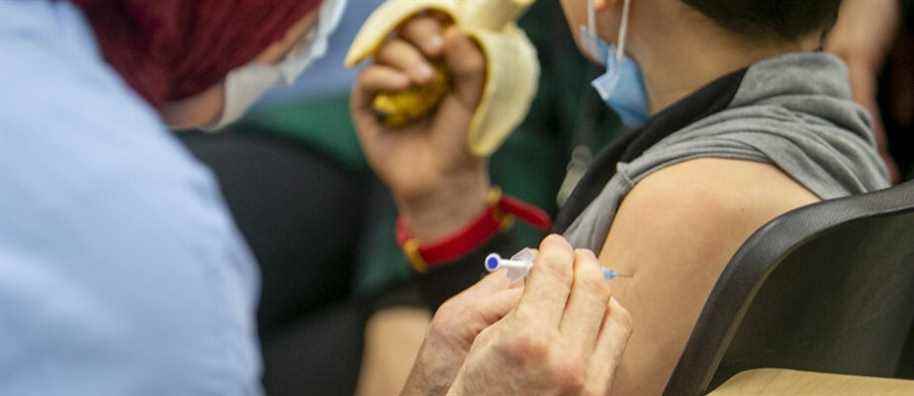The projections of the National Institute of Public Health of Quebec (INSPQ) on the evolution of COVID-19 show that the vaccination of children could significantly reduce the number of new cases and hospitalizations after the holidays.
These projections obviously do not take into account the impact that the emergence of a new variant, called Omicron, which was discovered to exist this week and which is causing great concern around the world, could have. led most governments, including that of Canada, to suspend flights from southern Africa.
“Vaccinating children is one more protection against increased transmission. Having said that, you have to be careful. There are two elements that are uncertain: the duration of protection and the variants with a possible vaccine escape ”, specifies Marc Brisson, co-author of the study, full professor at Laval University and director of the Mathematical Modeling Research Group. and in health economics linked to infectious diseases from the CHU de Québec research center, in an interview with Press.
This qualification being made, we note that in the various scenarios presented by the INSPQ, the effect of the vaccination of children aged 5 to 11 changes the situation.

“The message is that any additional coverage is good. We hope to have the highest possible coverage, but even at 45% and 50%, there is a significant impact of childhood vaccination on community transmission, says Mr. Brisson. These percentages more give us more flattened curves. ”
Two projections
The organization’s report includes two separate sets of projections, the first for Greater Montreal, the second for other regions of Quebec. In both cases, they measure two hypotheses: a respect for reduced contacts in November and December, and a return to pre-pandemic contacts during the same period.
“According to the scenario of increased contacts in the fall (return to the level of pre-COVID contacts), the model predicts an increase in cases and hospitalizations in Greater Montreal, due to the increase in community transmission. The peaks of cases and hospitalizations could be between those of the 2e and 3e waves (January and April 2021, respectively) and could be reached in January / February 2022, ”the report notes.
However, the impacts will be more moderate if Montrealers have respected the health rules. “Under the fall-reduced contact maintenance scenario, the model predicts a flattening of the case and hospitalization curve,” the researchers say.
A lower number of cases in December could limit intergenerational transmission during the holiday season and, consequently, hospitalizations in January 2022.
Extract from the report of the National Institute of Public Health of Quebec
Change of trajectory
Which of these scenarios is more likely?
“I think, as with everything with COVID-19, it’s about preparing for the worst and hoping for the best. That’s what we do with our scripts. We show what could happen in a pessimistic way and what could happen in an optimistic way, and often, we find ourselves somewhere in between, ”answers Marc Brisson.
“What is clear is that the higher the vaccination coverage in the total population, the more difficult it is to have an increase in transmission,” he adds.
This is what can happen with the vaccination of children. Projections show that this causes a marked change in the trajectory of the evolution of cases. The increase in cases remains significant in the scenario with resumption of contact, but without reaching the peaks observed last January. As for hospitalizations, they would be at the level of the third wave.
However, in the low contact scenario, vaccinating children significantly reduces the number of new cases and hospitalizations, enough to keep them at the fall level and prevent another peak in early 2022.
These projections are based on a vaccination coverage of children (first dose) of 70 to 75% within five to six weeks, the achievement of which seems plausible. But even if the vaccination is lower, at 50% for example, “we will be better equipped to fight against unknown elements, such as a loss of vaccine efficacy or new variants,” says Mr. Brisson.
“In Quebec, we have good protection for the moment, but you have to know what the characteristics of this new variant will be [Omicron] and monitor vaccine efficacy, ”adds the director of the Research Group.
When we talk about waves, the future is a little uncertain, but what we can do now is to monitor the situation in terms of the duration of protection and to study the characteristics of the new variants.
Marc Brisson, co-author of the study
In the regions
The projections made for the other regions of Quebec take into account the different evolution of the pandemic. But the general conclusions on the negative impact that a return to pre-pandemic social behavior would have and on the positive impact of childhood vaccination remain the same.
“Vaccination of children could limit the increase in transmission that could occur during the holiday season with the increase in intergenerational contact (percolation of cases from children to adults),” the report said.
“Vaccinating children would also reduce hospitalizations in all age groups by limiting community transmission (especially among unvaccinated people). ”

